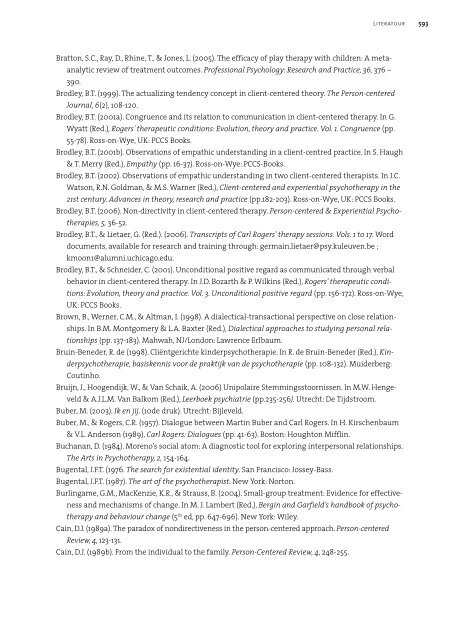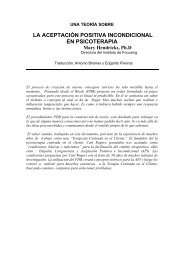8 Focusing en de experiëntiële aspecten van psychotherapie
8 Focusing en de experiëntiële aspecten van psychotherapie
8 Focusing en de experiëntiële aspecten van psychotherapie
Create successful ePaper yourself
Turn your PDF publications into a flip-book with our unique Google optimized e-Paper software.
Literatuur<br />
Bratton, S.C., Ray, D., Rhine, T., & Jones, L. (2005). The efficacy of play therapy with childr<strong>en</strong>: A meta-<br />
analytic review of treatm<strong>en</strong>t outcomes. Professional Psychology: Research and Practice, 36, 376 –<br />
390.<br />
Brodley, B.T. (1999). The actualizing t<strong>en</strong>d<strong>en</strong>cy concept in cli<strong>en</strong>t-c<strong>en</strong>tered theory. The Person-c<strong>en</strong>tered<br />
Journal, 6(2), 108-120.<br />
Brodley, B.T. (2001a). Congru<strong>en</strong>ce and its relation to communication in cli<strong>en</strong>t-c<strong>en</strong>tered therapy. In G.<br />
Wyatt (Red.), Rogers’ therapeutic conditions: Evolution, theory and practice. Vol. 1. Congru<strong>en</strong>ce (pp.<br />
55-78). Ross-on-Wye, UK: PCCS Books.<br />
Brodley, B.T. (2001b). Observations of empathic un<strong>de</strong>rstanding in a cli<strong>en</strong>t-c<strong>en</strong>tred practice. In S. Haugh<br />
& T. Merry (Red.), Empathy (pp. 16-37). Ross-on-Wye: PCCS-Books.<br />
Brodley, B.T. (2002). Observations of empathic un<strong>de</strong>rstanding in two cli<strong>en</strong>t-c<strong>en</strong>tered therapists. In J.C.<br />
Watson, R.N. Goldman, & M.S. Warner (Red.), Cli<strong>en</strong>t-c<strong>en</strong>tered and experi<strong>en</strong>tial psychotherapy in the<br />
21st c<strong>en</strong>tury. Ad<strong>van</strong>ces in theory, research and practice (pp.182-203). Ross-on-Wye, UK: PCCS Books.<br />
Brodley, B.T. (2006). Non-directivity in cli<strong>en</strong>t-c<strong>en</strong>tered therapy. Person-c<strong>en</strong>tered & Experi<strong>en</strong>tial Psychotherapies,<br />
5, 36-52.<br />
Brodley, B.T., & Lietaer, G. (Red.). (2006). Transcripts of Carl Rogers’ therapy sessions. Vols. 1 to 17. Word<br />
docum<strong>en</strong>ts, available for research and training through: germain.lietaer@psy.kuleuv<strong>en</strong>.be ;<br />
kmoon1@alumni.uchicago.edu.<br />
Brodley, B.T., & Schnei<strong>de</strong>r, C. (2001). Unconditional positive regard as communicated through verbal<br />
behavior in cli<strong>en</strong>t-c<strong>en</strong>tered therapy. In J.D. Bozarth & P. Wilkins (Red.), Rogers’ therapeutic conditions:<br />
Evolution, theory and practice. Vol. 3. Unconditional positive regard (pp. 156-172). Ross-on-Wye,<br />
UK: PCCS Books.<br />
Brown, B., Werner, C.M., & Altman, I. (1998). A dialectical-transactional perspective on close relationships.<br />
In B.M. Montgomery & L.A. Baxter (Red.), Dialectical approaches to studying personal relationships<br />
(pp. 137-183). Mahwah, NJ/London: Lawr<strong>en</strong>ce Erlbaum.<br />
Bruin-B<strong>en</strong>e<strong>de</strong>r, R. <strong>de</strong> (1998). Cliëntgerichte kin<strong>de</strong>r<strong>psychotherapie</strong>. In R. <strong>de</strong> Bruin-B<strong>en</strong>e<strong>de</strong>r (Red.), Kin<strong>de</strong>r<strong>psychotherapie</strong>,<br />
basisk<strong>en</strong>nis voor <strong>de</strong> praktijk <strong>van</strong> <strong>de</strong> <strong>psychotherapie</strong> (pp. 108-132). Mui<strong>de</strong>rberg:<br />
Coutinho.<br />
Bruijn, J., Hoog<strong>en</strong>dijk, W., & Van Schaik, A. (2006) Unipolaire Stemmingsstoorniss<strong>en</strong>. In M.W. H<strong>en</strong>geveld<br />
& A.J.L.M. Van Balkom (Red.), Leerboek psychiatrie (pp.235-256). Utrecht: De Tijdstroom.<br />
Buber, M. (2003). Ik <strong>en</strong> jij. (10<strong>de</strong> druk). Utrecht: Bijleveld.<br />
Buber, M., & Rogers, C.R. (1957). Dialogue betwe<strong>en</strong> Martin Buber and Carl Rogers. In H. Kirsch<strong>en</strong>baum<br />
& V.L. An<strong>de</strong>rson (1989), Carl Rogers: Dialogues (pp. 41-63). Boston: Houghton Mifflin.<br />
Buchanan, D. (1984). Mor<strong>en</strong>o’s social atom: A diagnostic tool for exploring interpersonal relationships.<br />
The Arts in Psychotherapy, 2, 154-164.<br />
Bug<strong>en</strong>tal, J.F.T. (1976. The search for exist<strong>en</strong>tial id<strong>en</strong>tity. San Francisco: Jossey-Bass.<br />
Bug<strong>en</strong>tal, J.F.T. (1987). The art of the psychotherapist. New York: Norton.<br />
Burlingame, G.M., MacK<strong>en</strong>zie, K.R., & Strauss, B. (2004). Small-group treatm<strong>en</strong>t: Evid<strong>en</strong>ce for effectiv<strong>en</strong>ess<br />
and mechanisms of change. In M. J. Lambert (Red.), Bergin and Garfield’s handbook of psychotherapy<br />
and behaviour change (5th ed, pp. 647-696). New York: Wiley.<br />
Cain, D.J. (1989a). The paradox of nondirectiv<strong>en</strong>ess in the person-c<strong>en</strong>tered approach. Person-c<strong>en</strong>tered<br />
Review, 4, 123-131.<br />
Cain, D.J. (1989b). From the individual to the family. Person-C<strong>en</strong>tered Review, 4, 248-255.<br />
593










